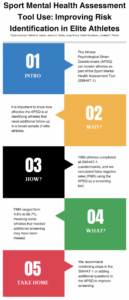In 2021, the International Olympic Committee introduced the Sport Mental Health Assessment Tool (SMHAT-1) to screen athletes for mental health concerns. This tool consists of a series of steps to evaluate an athlete’s mental well-being. The first step involves completing the Athlete Psychological Strain Questionnaire (APSQ), which helps determine if further assessment is necessary. Athletes scoring 17 or higher on the APSQ complete additional questionnaires targeting specific mental health concerns such as anxiety, depression, sleep, substance misuse, and eating disorders. Clinicians review the results in the final step and provide appropriate recommendations for further support if needed. This blog summarizes a recent study that evaluated the ability of the APSQ to identify athletes at risk of declining/poor mental health (1).
Why is this study important?
In developing the SMHAT-1, careful consideration was given to which questionnaires to use, including the initial triage questionnaire, the APSQ. While the APSQ has been empirically demonstrated to be a reliable tool in identifying mental health risk factors in athletes (2), the principal validation study involved athletes from only three summer sports, with most participants being male (3). This may affect the questionnaire’s applicability to athletes from different sports, sexes/genders, age groups, and countries. To address these concerns, we evaluated the effectiveness of the APSQ in identifying at-risk athletes across a broad elite sport population. To do so, we had athletes complete the APSQ and all SMHAT-1 secondary screeners to determine the rate at which the APSQ potentially failed to identify athletes who were flagged on the secondary screeners. Our ultimate goal was to determine whether the SMHAT-1 screener (i.e., APSQ) was sensitive enough to identify all athletes who were subsequently flagged on the secondary SMHAT-1 tests.
How did the study go about this?
In this study, we conducted a retrospective analysis of SMHAT-1 responses from 1,066 (518 males, 548 females) Team USA athletes, many of whom were participating in the Tokyo 2020 and Beijing 2022 Olympic and Paralympic Games Games. In contrast to the recommended SMHAT-1 guidelines, we asked athletes to complete the APSQ and all subsequent SMHAT-1 questionnaires regardless of their APSQ score. Among other analyses, we calculated false negative rates (FNR) for athletes who scored below the APSQ threshold but above the subsequent questionnaire thresholds.
What did the study find?
When comparing by sex, females had higher scores on the APSQ and questionnaires assessing anxiety, depression, and disordered eating but lower scores on alcohol misuse than males. There were no significant differences between Paralympic and Olympic athletes. This is displayed in the below figure (Figure 1).

Figure 1: Differences between APSQ and other questionnaires, comparing males and females
The false negative rate (FNR) for athletes scoring below the APSQ threshold but above subsequent questionnaire thresholds ranged from 4.8% (depression) to 66.7% (disordered eating). The overall FNR for APSQ was 67.4%. Females generally had lower FNR than males, and Paralympic athletes had lower FNR than Olympic athletes. Of particular concern, we found that the FNR for the question regarding self-harm and suicidal ideation was 6.7%, meaning that if we only used the APSQ, we would have been at risk of missing athletes who required clinical follow-up, assessment, and treatment.
What are the key take-home points?
Based on these findings, we recommend changes to the deployment of the SMHAT-1, such as combining steps 1 and 2 for initial triage or, if time, personnel, or financial resources are limited, adding a suicide and self-harm risk question to the APSQ. The SMHAT-1 is an incredibly valuable tool for sports medicine professionals to help detect athletes that could benefit from mental health services. We intend to continue deploying the SMHAT-1 with Team USA athletes whilst continuing to find opportunities to improve its use to best serve and provide comprehensive health care to Team USA athletes.

References:
-
Anderson T, Adams WM, Bartley JD, et alAnalysis of the Sport Mental Health Assessment Tool 1 (SMHAT-1) in Team USA athletes British Journal of Sports Medicine Published Online First: 27 June 2023. doi: 10.1136/bjsports-2022-106495
-
Kessler RC, Andrews G, Colpe LJ, et al. Short screening scales to monitor population prevalences and trends in non-specific psychological distress. Psychol Med. 2002;32(6):959-976.
-
Rice S, Olive L, Gouttebarge V, et al. Mental health screening: severity and cut-off point sensitivity of the athlete psychological strain questionnaire in male and female elite athletes. BMJ Open Sport Exerc Med. 2020;6(1):e000712.
Authors: Travis Anderson, William M. Adams, Jessica D. Bartley, Angel Brutus, Amber Donaldson, Jonathan T. Finnoff